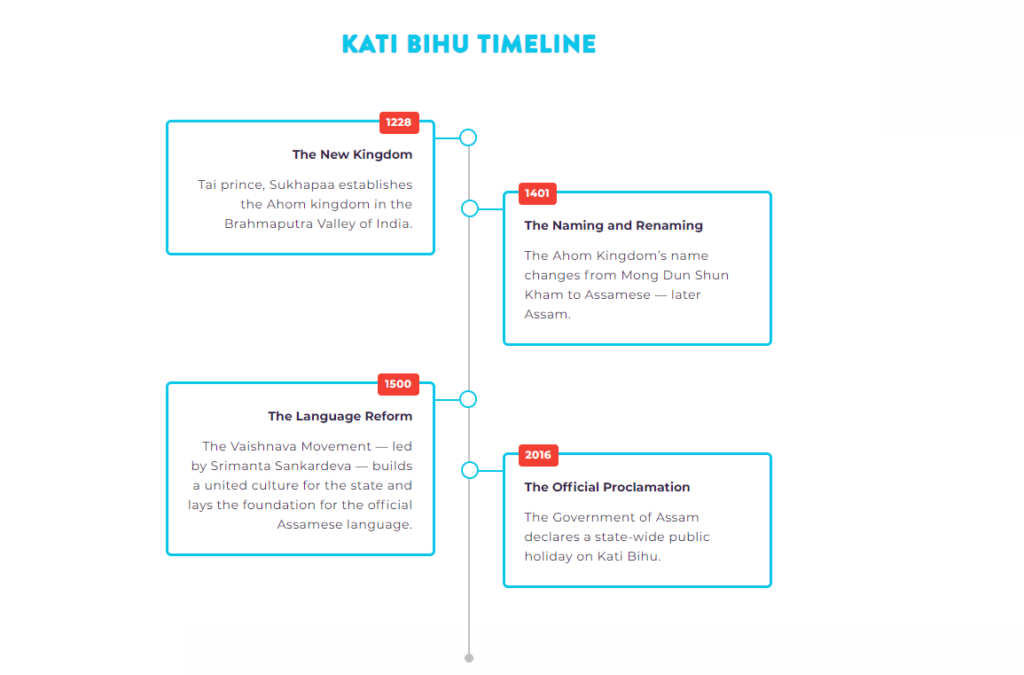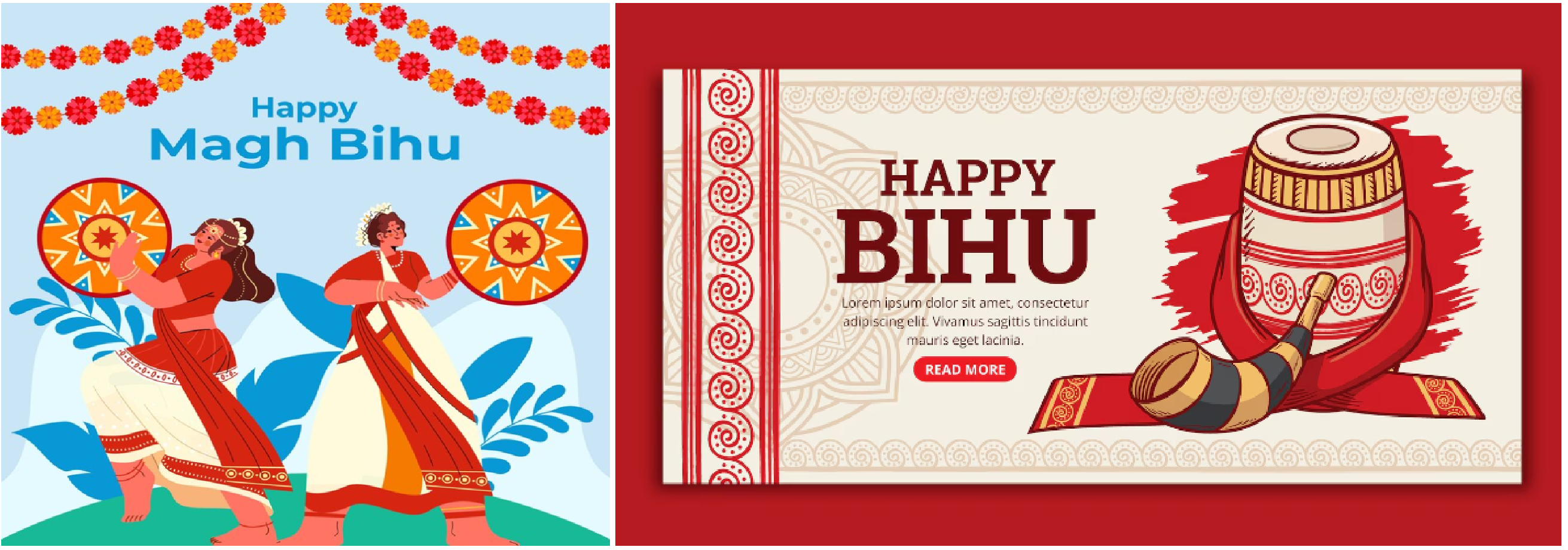Kati Bihu Festival 2024 : Kati Bihu, also known as Kongali Bihu, is one of the three Bihu festivals celebrated in the Indian state of Assam, the other two being Rongali (Bohag) Bihu and Bhogali (Magh) Bihu. Kati Bihu is observed in mid-October, typically around October 18.
The word “Kongali” means “poor” or “meager,” reflecting the somber nature of the festival, as it is held during a time when resources are sparse, and the granaries are low before the next harvest. This is in contrast to the other Bihu festivals, which are more joyous and involve feasting. Here are some of the key aspects of Kati Bihu:
Significance:
- Agricultural Rituals: Kati Bihu marks a crucial time in the agricultural calendar, as it is the phase when the paddy (rice) crop is at the growing stage, and farmers pray for a good harvest.
- Lighting of Lamps: One of the most significant customs of Kati Bihu is the lighting of earthen lamps or clay diyas at the base of the tulsi (holy basil) plant in Assamese homes and in the paddy fields. This practice is believed to protect the crops and ward off evil spirits.
- Worship of Goddess Lakshmi: People also worship Goddess Lakshmi, the goddess of wealth and prosperity, seeking her blessings for a bountiful harvest.
- Lighting of Akash Banti: Another important tradition is the lighting of the Akash Banti (sky lanterns), which are lamps placed on high bamboo poles. These are believed to guide ancestors’ souls and ensure good fortune.
Rituals:
- Tulsi Plant Worship: The tulsi plant is central to the rituals of Kati Bihu. People clean the area around the plant, light an earthen lamp, and offer prayers for prosperity.
- Fasting and Simplicity: Unlike Rongali Bihu, which is marked by grand celebrations, Kati Bihu is observed with simplicity. Some people fast during the day as a form of penance and to invoke divine blessings for the upcoming harvest.
- Recitation of Prayers and Mantras: Many households chant prayers and mantras to protect the crops from pests and natural calamities.
Social and Cultural Impact:
- Kati Bihu reflects the deep connection between the people of Assam and their agricultural lifestyle. It is a time of hope and prayers for future prosperity, a reminder of the cycles of nature, and the need for patience and perseverance.
- While it lacks the grandeur of other festivals, Kati Bihu holds immense cultural significance in the agricultural life of Assam.
- असम में काटी बिहू उत्सव के बारे में
तीन प्रमुख बिहू त्योहारों में से एक माना जाने वाला काटी बिहू चावल के पौधों के स्थानांतरण का समय दर्शाता है। इस त्योहार को कोंगाली (गरीब) के रूप में भी जाना जाता है, जो वर्ष के उस समय खाली अन्न भंडार और कम खाद्य उपलब्धता का प्रतीक है। इसलिए, काटी बिहू को अन्य दो बिहू त्योहारों की तरह भव्य रूप से नहीं मनाया जाता है। - इस त्योहार को मनाने के लिए घर के विभिन्न स्थानों पर दीये या साकी (मोमबत्तियाँ) जलाई जाती हैं। मुख्य दीया आंगन में रखा जाता है जहाँ तुलसी का पौधा मौजूद होता है। त्योहार के लिए तुलसी के पौधे को साफ किया जाता है और उसे “तुलसी भेटी” नामक मिट्टी के मंच पर रखा जाता है। लोग प्रसाद चढ़ाते हैं और अपने परिवार की भलाई और अच्छी फसल के लिए देवी तुलसी से प्रार्थना करते हैं। यह अनुष्ठान पूरे काटी महीने तक जारी रहता है।
- लोग अपने धान के खेतों में “आकाश बंती” (आकाश मोमबत्ती) नामक एक विशेष दीपक भी जलाते हैं। इन दीयों में सरसों का तेल होता है और इन्हें बाँस के खंभों की नोक पर ऊँचा रखा जाता है। लोगों का मानना है कि ये जलते हुए दीये उनके पूर्वजों को स्वर्ग की ओर ले जाएंगे। इन दीयों को जलाने का एक और उद्देश्य कीटों को आग की लपटों की ओर आकर्षित करना है ताकि उन्हें मारा जा सके और फसलों की रक्षा की जा सके।
कटि बिहू अनुष्ठान Kati Bihu Significance
कटि बिहू के दौरान किए जाने वाले अनुष्ठानों की सूची इस प्रकार है:
- कटि बिहू 2024 में 17 अक्टूबर को मनाया जाएगा
- ‘तुलसी भेटी’ तैयार की जाती है, जो एक मिट्टी का मंच होता है, जिस पर साफ तुलसी का पौधा रखा जाता है
- परिवार की खुशहाली और अच्छी फसल के लिए इस त्यौहार के दौरान देवी तुलसी की पूजा की जाती है
- यह त्यौहार पूरे कटि महीने तक मनाया जाता है
- इस त्यौहार के दौरान धान के खेत में विशेष दीपक जलाए जाते हैं
- कीटों को आग की लपटों की ओर आकर्षित करके फसलों की रक्षा के लिए दीपक जलाया जाता है
काटी बिहू का महत्व
काटी बिहू के निम्नलिखित महत्व हैं:
- तीनों बिहू त्यौहार कृषि से जुड़े हैं
- काटी का अर्थ है काटना और इस दौरान चावल के पौधे को दूसरी जगह लगाया जाता है
- काटी बिहू को कोंगाली बिहू के नाम से भी जाना जाता है
- कोंगाली बिहू नाम इसलिए रखा गया है क्योंकि इस समय अन्न भंडार खाली हो जाते हैं और खाने के लिए कुछ नहीं बचता
- घर के अलग-अलग हिस्सों में दीये या मोमबत्तियाँ जलाई जाती हैं
- काटी बिहू के दौरान पवित्र तुलसी के पौधे के पास मुख्य दीया जलाया जाता है |

काटी बिहू अक्सर पूछे जाने वाले प्रश्न
काटी बिहू को कंगाली बिहू क्यों कहा जाता है?
- तीसरा बिहू त्यौहार, काटी बिहू को कंगाली बिहू भी कहा जाता है – ‘कंगाली’ से, जिसका अर्थ है ‘गरीब’ – क्योंकि साल के इस समय तक एक साधारण परिवार के घर में अनाज नहीं होता है, क्योंकि अगली फसल से पहले स्टॉक आमतौर पर खत्म हो जाता है।
आप असमिया में बिहू की शुभकामनाएँ कैसे देते हैं?
- हैप्पी बिहू! इस असम त्यौहार के साथ, आप एक नया साल और जीवन में एक नया रोमांच शुरू करेंगे। नमस्ते, बिहू! भगवान इस बिहू त्यौहार के दौरान सभी को सफलता और पूर्णता प्रदान करें!
काटी बिहू में तपस्या करना क्यों महत्वपूर्ण है?
- काटी बिहू उस समय मनाया जाता है जब पिछली फसल का संग्रहीत अनाज खत्म होने वाला होता है, और भविष्य की एकमात्र आशा एक समृद्ध नई फसल होती है। इसलिए पूर्वजों की शक्तियों का आह्वान किया जाता है और भगवान से दया की भीख माँगी जाती है।

